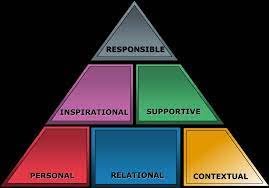Climbing the Pyramid – Inspirational & Supportive Leadership
OK, maybe you think you know what “inspirational” and “supportive” mean.
For example, when we talk about successful founders, it’s often about how inspiring they are - their big vision. How captivating they are. But inspirational leaders are not someone with charisma, a winning personality, or other worldly presence.
So, what do these words really mean? Today, I am coming back to the Six Domains of Leadership (“SDL”).
Specifically, level 2, Inspirational and Supportive. They go hand in hand.
Inspirational Leadership
Inspirational leaders foster a culture of excellence, build enthusiasm for the organization’s vision and goals, and promote optimism.
It is not so much about setting high standards as it is about instilling an expectation of excellence. Jack Welsh, long-time CEO of General Electric, has said that people tend to set goals for themselves that are higher than those that leader set forth. We also know that expectations about performance are self-fulfilling.
Inspired and inspirational leaders see what is possible that others don’t see, and they are able to get buy-in from their team, for that vision and that it is achievable. Founders see the white space and go after what seems impossible. They are called “crazy” by friends, family, peers, and, perhaps, investors 100s of times.
Inspirational leadership is also about generating and maintaining enthusiasm for the organization’s goals and for tackling big challenges. Your enthusiasm spreads and fuels collective enthusiasm. Your excitement, when palpable (aka not cheesy slogans on the wall) inspires others.
Finally, with high expectations and enthusiasm for big goals, leaders need to instill a sense of optimism that it is possible. The goals achievable.
You can’t just set an expectation of excellence without equally conveying confidence in the team’s ability to accomplish exceptional work.
Inspirational leadership results in greater innovation and higher aspirations for each member of your team. You leave them feeling like they are invincible, ok that might be a wee bit of hyperbole, but feeling like they can do more than they ever thought possible.
“The greatest leader is not necessarily the one who does the greatest things. He is the one that gets the people to do the greatest things.” – Ronald Reagan
Supportive Leadership
Inspirational raises the bar. Supportive raises the floor.
Pretty much sums it up. Kidding (ish). The SDL model sets out three key elements (1) efficacy, (2) security, and (3) blame control.
You help your team members understand and appreciate their capacity, individually and as a whole. You promote ambition, a belief in their ability.
Security means providing the necessary resources for your team, for example, funding, new technology, or relevant training. It also means providing cover from external or internal politics. You take the hit for the big bold moves that don’t work out.
Blame control is a well-known concept. A great leader shoulders the blame for the failures and gives credit to his or her team for the wins. To accomplish greatness, teams must take smart risks and get outside their comfort zones. If someone thinks they are going to be blamed for a failed experiment, for taking a risk, they will think ‘why bother’. Builds complacency.
Supportive leadership results in a team that takes initiative, that makes decisions confidently, and takes informed risks, knowing you have their back.
Put it all together and you end up with high performance teams that deliver results and elevate their members to do more, be more, and learn more.
Thinking you might need a guide to get you to the top of the pyramid? A little help setting the foundation? Setup a 30-min, no commitment, strategy call.

